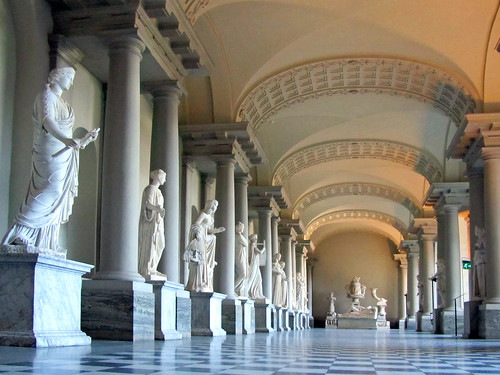
Gustav III Museum of Antiquities is a rather peculiar museum. It is a museum of a museum, that is, it is a museum recreated based on the museum which used to be housed at the Royal Palace. For a period of time, these pieces were moved to National Museum. They were subsequently restored at the Palace once again, and reopened as Museum of Antiquities. Therefore, this is a museum honouring what was one of the oldest European museums.
The museum is not particularly big, consisting of only two galleries. The bigger one containing a number of key statues, including Apollo and his nine muses, and Endymion, while the narrower gallery is used to mostly display busts of men of fame in the past. What’s quite amusing was listening to the guide explaining how rogue merchants of the past classified something as an object of antiquities from Roman civilisation. Apparently, as long as there’s at least 30% of original parts to the work, it was considered antiquities. And missing parts (limbs, attributes) can subsequently be replaced by, say, reconstructive sculpting works. Intriguing.

I never quite get nymphs, sirens and water spirits straight. I’ve seen the terms used interchangeably in some writings, while other sources portray them as distinct creatures, albeits water/sea related. Who’s right and who’s wrong? However, I do think of nymphs and sirens as creatures with seductive nature, so I would deduce this sculpture to be a water spirit if anything. Just look at it – she’s so young and carefree!
Pont Alexandre III is undoubtedly the most elaborately decorated and opulent bridge of Paris. This water spirit is only a small component to the bridge which spans River Seine to link Les Invalides on the left bank to both Grand Palais and Petit Palais on the right bank. From gold-gilded statues to Art Nouveau lamps to bronze sculptures, this bridge is, and will always be, a wow factor to all visitors to Paris.
Ps: yup, French wiki confirmed this is a water spirit (génie).

The seat of major EU institutions are in Strasbourg, among them the European Parliament and the Council of Europe. The buildings are modern, mostly glass and steel, which is quite a contrast to the quaint city centre area of Strasbourg, where Alsatian architecture (often feels Germanic) dominates. Of course, the city has been in both the hands of French and German over the centuries, so it’s natural that the influence from both cultures can be deeply felt.
Outside the European Parliament, this sculpture above drawn me to it. From afar, I initially thought it was the figure of strong protecting the weak, or a mother holding a child. Upon closer inspection though, it was more like entertwining embrace of a couple, encased in a loose heart shape. Designed Ludmilla Tcherina, this is a strong imagery of Europe that has a heart.

A new series of sculpted installation (made from rusty steel) has just been peppered along Ports de Paris which opened today. Such serendipitious coincidence that I went awandering near Parc André Citroën and came across a few of them. I haven’t time to check all of them out though. Accordingly they could be found along River Seine running from the park to the Eiffel Tower.
Created by Edgardo Carmona, the pieces by the quay-side gates of the park include the artistics (carnival musician, bike juggler, ribbon gymnast), the day-to-day (umbrella blown with the wind) and the amusing (man with beer – after a late night out maybe – and dog, both peeing to a lamp post). I wonder what else are installed upriver from here.
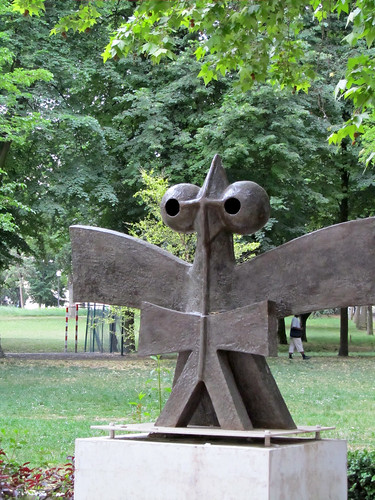
I pass by this bronze sculpture of a bird several times a week. In fact, each time I go for a run. Considering I would also complete numerous rounds of the loop of the park in Cité U, I’d see it for a few times within the hour that I huff and I puff my route in synchrony to whatever high-beat music I have loaded to my iPod.
Entitled Pájaro XIII (to signify the 13th such bronze statue by the same sculptor?) by Juan Soriano, it is part of collection from Centro de Arte de Reina Sofía. Unsurprising, given that it sits in the garden to the Spanish House. The thing is though, this sculpture is superfamiliar to me, even before I found out from where it came from. Now I wonder if I have saw something similar when I was in Madrid a few years back?

I <3 Miró. I first fell in love with him when I was in London, standing in one of the many rooms of Tate Modern, gazing at Message d’ami (Message from a friend). I was immediately smitten. What started as an attempt to get acquainted with modern art (I used to be a tad scathing about modern art movement) became a day of exploration and unspoken connection. That day, I learned a true lesson in the beauty of keeping an open mind and giving things a try. At least once.
At Musée Maillol, an exhibition of Miró’s sculptures is currently taking place and it is so good to see the familiar elements of his paintings also reflected in the sculptures. The one thing missing is the bold colour blocks, given most of the sculptures were casted in bronze and not cured in any other way. I miss those vibrant colours. There are a couple of coloured preparatory sketches in exhibition, along with 2-3 paintings proper, but that’s too few for my liking.
In writing this blog post, I discovered that another Miró exhibition is currently running in Tate Modern, which assembles paintings from public and private collection (what a coup!). I need to now find some free time to Eurostar myself over to London. Oh where in my calendar can I fit this in…?
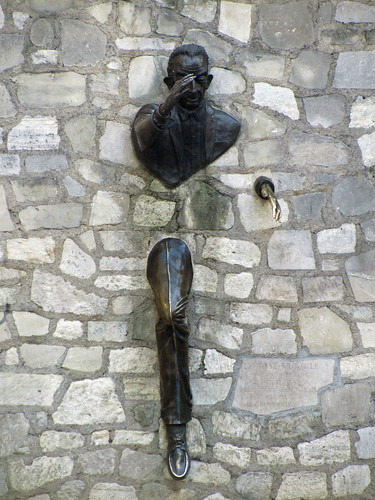
Many years ago, Marcel Aymé wrote a short story called Le Passe-Muraille (The man who walks through the wall) and it became of one his most famous works. Set in Montmartre, at rue Norvins, where Aymé lived, the protagonist Dutilleul found himself with most unusual talent for walking through walls but later accidentally “cured” himself and was stuck in a wall following a late night rendezvous. Poor guy had no one but the painter Eugene Paul who occasionally sang, accompanied by a guitar, as consolation. (Read the translated work here.)
Today, at the corner of rue Norvins, sits a bronze sculpture to honour Aymé and this short story of his. It is a poetic tribute, for the location commemorates not only where Dutilleul found himself imprisoned for life, but also the writer himself living in the building just adjacent to the wall. Visitors today seem to believe that rubbing the hand of the sculpture would bring good fortune. The proof – shiny and sparkling hand of the bronze figure. ;)
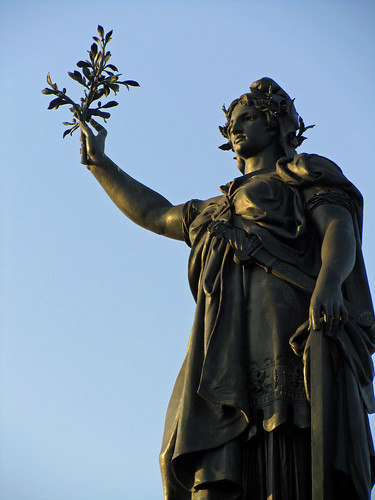
Sure, this is no Laetitia Casta (who was voted in 1999 as symbolic representation of French Republic) but Marianne is everywhere, celebrated in form of monumental sculptures, leading lady in paintings, the caricature on the stamps, even carried daily in our pockets as the French euro coins are engraved with her image.
Standing tall – it is 9.5m in height – and dominant at Place de la République, this bronze sculpture of Marianne by Léopold Morice sits above a base of 15m in height with three other sculptures of the allegories to Liberté, Égalité and Fraternité by Charles Morice. The brothers effectively executed a perfect classical monument to represent the state, for the values that her people fought for in the French Revolution.
I’ve tried to photograph this monument in its entirety but at that time of day, with traffic teeming around the square and people everywhere, I couldn’t find a frame that I like, that I’m happy with. Maybe I should try some day really early in the morning?
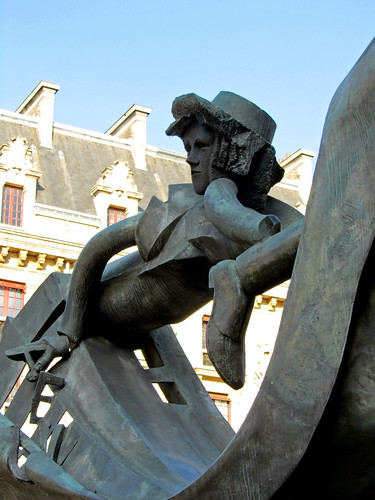
I first noticed this unusual and whimsical sculpture at place du Père-Teilhard-de-Chardin during a leisurely walk with the girls a couple of weekends ago, and when my random bus exploration took me past it again, I deboarded the bus quickly at the next stop.
A commission carried out by late Jean-Robert Ipoustéguy, this sculpture from mid-1980 parodically depicted the poet Arthur Rimbaud. A restless soul who travelled constantly, Rimbaud had earned himself the nickname l’Homme aux semelles de vent (“man with soles of wind”). Cleverly playing with the homophonic title l’Homme aux semelles devant (“man with soles in front [of him]”), Ipoustéguy had Rimbaud resting upon someone’s soles, perhaps his own, as the body was split in two and time-wrapped in a peculiar machine.
This is a prime example of the relationship between French(wo)men and their love of language. From whatever little I managed to glean from the French culture, everyone seems to thrive on smart plays of words, compositions that are linguistically beautiful, the subtleties in nuances of literature. How else do you explain George Perec’s lipogrammic writing of La disparition? Or the creation of verlanised verlan? Or the delight of my French teacher in showing us “the 8 flavours of passé composé” and the anticipation of other rich variations of all the other tenses? ;)
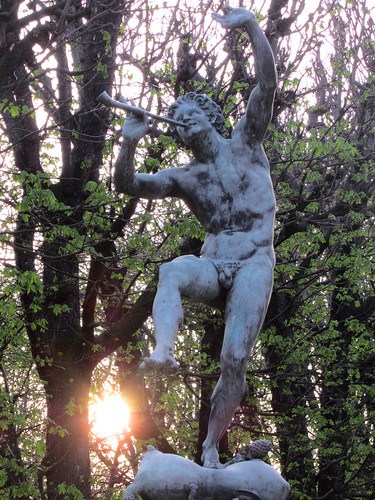
There are statues and sculptures aplenty in Luxembourg Garden, including replica of the Statue of Liberty. Random information of the day: the Statue of Liberty is French by nationality, designed by Frédéric Bartholdi and brought to life by Gustave Eiffel, who was assisted by Maurice Koechlin. The completed statue was disassembled and shipped in crates across the ocean before being reassembled – the latter took some six months for the erection to be completed.
Back to the sculpture above. Named “Faune dansant” (i.e. dancing faun), this sculpture of merriment and music can be found close to the site of the Medici Fountain in Luco. Despite the name, the depiction is really that of a satyr rather than a faun, which is half goat, half human. In mythology, satyrs are pipe-carrying and dance-loving creatures. Looking at this sculpture, I half expect woodwind tunes to fill the air, so I can close my eyes and twirl to the melody.






















